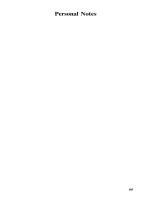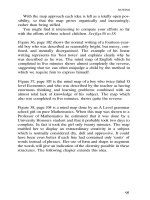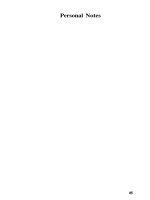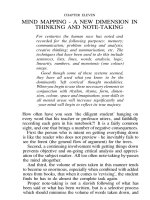tony buzan mind maps and making notes phần 5 ppt
Bạn đang xem bản rút gọn của tài liệu. Xem và tải ngay bản đầy đủ của tài liệu tại đây (92.57 KB, 11 trang )
Personal Notes
105
C: Mind maps - advanced methods
and uses
Overview
• Models for the brain
• Technology and new insights into ourselves
• The left and right brain and mind mapping
• Advanced techniques
• Wider application of patterning techniques
106
NOTING
Models of perception - brain - mind
As recently as the 1950s the camera provided the model for our
perception and mental imaging: the lens of the camera corres-
ponded to the lens of the eye, and the photographic plate to the
brain itself. See fig 39. This conception was held for some time
but was very inadequate. You can confirm this inadequacy by
doing the following exercises: in the way that one normally does
when drowsily day-dreaming, close your eyes and imagine your
favourite object. Having clearly registered the image on your in-
ner eye, perform the following activities.
• Rotate it in front of you
• Look at it from the top
• Look at it from underneath
• Change its colour at least three times
• Move it away as if it were seen from a long distance
• Bring it close again
• Make it gigantic
• Make it tiny
• Totally change the shape of it
• Make it disappear
• Bring it back
These feats can be performed without much difficulty; the
apparatus and machinery of a camera could not even begin to
perform them.
camera lens
photographic
plate
object
human eye
human brain
object
Fig39 Contrary to earlier thought the brain operates in a much
more complex manner than the camera. See text this page.
107
retina
optic
nerve
occipital
lobe
Modern technology
Recent developments in more refined technology have fortu-
nately given us a much better analogy: the hologram.
In this technique, an especially concentrated light or laser
beam is split into two. One half of the ray is directed to the plate,
while the other half is bounced off the image and then directed
back to the other half of the ray. The special holographic plate
records the millions of fragments into which the rays shatter
when they collide. When this plate is held up in front of laser
beams directed at special angles towards it, the original image is
recreated. Amazingly, it is not recreated as a flat picture on the
plate, but is perfectly duplicated as a three-dimensional ghost
object that hangs in space. If the object is looked at from above,
below or the side, it is seen in exactly the same way as the original
object would be seen.
Even more amazingly, if the original holographic plate is ro-
tated through 90 degrees, as many as 90 images can be recorded
on the same plate with no interference.
And to add still further to the extraordinary nature of this new
development, if the plate is taken and smashed to smithereens
with a hammer, each particle of the shattered plate will, when it
is placed in front of the specially direct lasers, still produce the
complete three-dimensional ghost.
The holograph thus becomes a far more reasonable model
than the camera for the way in which our brain works, and begins
to give us some idea of just how complex an organism it is that
we carry about with us.
But even this extremely refined piece of technology falls far
short of the unique capabilities of the brain. The holograph cer-
tainly approximates more closely the three-dimensional nature of
our imaginations, but its storage capacity is puny compared to
the millions of images that our brains can call up at an instant's
notice, and randomly. The holograph is also static. It cannot per-
form any of the directional exercises of the kind described on
pages 107 and 108 which the brain finds so easy and yet which
must involve the most unimaginably intricate machinery. And
even if the holograph were able to accomplish all this, it would
108
NOTING
not be able to do what our minds can: to see its own self, with
eyes closed, performing the operations!
The above gives considerable cause for thought, and even our
most advanced sciences have as yet made little progress in this
most interesting area of current research.
Advanced mind maps
Observing that the brain handles information better if the in-
formation is designed to 'slot in', and observing also the informa-
tion from this chapter about the dimensional nature of the mind,
it follows that notes which are themselves more 'holographic'
and creative will be far more readily understood, appreciated and
recalled.
There are many devices we can use to make such notes:
arrows
These can be used to show how concepts which appear
on different parts of a pattern are connected. The
arrow can be single or multi-headed and can show
backward and forward directions.
codes
Asterisks, exclamation marks, crosses and question
marks as well as many other indicators can be used next
to words to show connections or other 'dimensions'.
geometrical shapes
Squares, oblongs, circles and ellipses etc can be
used to mark areas or words which are similar in nature
- for example triangles might be used to show areas of
possible solution in a problem-solving pattern.
Geometrical shapes can also be used to show order of
importance. Some people, for example, prefer to use a
square always for their main centre, oblongs for the
ideas near the centre, triangles for ideas of next
importance, and so on.
artistic three dimension
Each of the geometrical shapes mentioned, and many
others, can be given perspective. For example, making
a square into a cube. The ideas printed in these shapes
will thus 'stand off the page.
109
creativity/images
Creativity can be combined with the use of dimension
by making aspects of the pattern fit the topic. One man,
for example, when doing a pattern on atomic physics,
used the nucleus of an atom and the electrons that
surrounded it, as the centre for his pattern.
colour
Colour is particularly useful as a memory and creative
aid. It can be used, like arrows, to show how concepts
which appear on different parts of the pattern are
connected. It can also be used to mark off the
boundaries between major areas of a pattern.
Mind Maps and the Left and Right Brain.
At this point it is useful to consider how recent research into the
brain adds strength to the points raised so far. In light of the fact,
as already outlined, that the brain handles information better if
the information is designed to 'slot in', consider the left and right
brain research of Roger Sperry and Robert Ornstein. This re-
search alone would lead you to conclude that a note taking and
thought-organisation technique designed to satisfy the needs of
the whole brain would have to include not only words, numbers,
order, sequence, and lines, but also colour, images, dimension,
symbols, and visual rhythms etc: in other words Mind Maps.
Fig 40 The left and right brain.
110
NOTING
Fig 41 A mind map on the uses of mind maps. See text page 112.
III
From whatever perspective one approaches the question, be it
from the nature of words and information, the function of recall,
holographic models of the brain, or recent brain research, the
conclusions in the end are identical - in order to fully utilise the
brain's capacity, we need to consider each of the elements that
add up to the whole, and integrate them in a unified way.
Mind maps - uses
The nature of mind maps is intimately connected with the func-
tion of the mind, and they can be used in nearly every activity
where thought, recall, planning or creativity are involved. Figure
41 is a mind map of the use of mind maps, showing this wide
variety of uses. Detailed explanation of each of these aspects
would of course take up a large book, but in the remainder of this
chapter I shall explain the application of maps to the speech writ-
ing, essay writing, examination type of task; to meetings and
communications, and to note taking.
Transforming a mind map to a speech, article etc.
Many people, when first shown mind maps, assume that they
cannot be used for any linear purpose, such as giving a talk or
writing an article. Nothing could be further from the truth. If you
refer to the mind map of this chapter on page 100, you will find
how such a transformation took place:
Once the map has been completed, the required information
is readily available. All that is necessary is to decide the final
order in which to present the information. A good mind map will
offer a number of possibilities. When the choice is being made,
each area of the map can be encircled with a different colour,
and numbered in the correct order. Putting this into written or
verbal form is simply a matter of outlining the major areas to be
covered, and then going through them point by point, following
the logic of the branched connections. In this way the problem of
redrafting and redrafting yet again is eliminated - all the gather-
ing and organising will have been completed at the map stage.
112
NOTING
Using these techniques at Oxford University, students were able
to complete essays in one third of the previous time while receiv-
ing higher marks.
Note taking
It is advisable, when taking notes, to have two blank pages
ongoing at the same time. The left-hand page should be for
mapped information and the right-hand page for more linear or
graphic information such as formulas, special lists, and graphs
etc. See fig 42.
When taking notes, especially from lectures, it is important to
remember that key words and images are essentially all that is
Fig 42 Recommended general form for note taking. Two pages should be
used concurrently, one for mind maps, the other for graphic or more linear
information. These example notes on body, mind and spirit may originally
'look messy' but they are in fact neater than traditionally 'neat' notes. See text
pages 112 and 114.
113
needed. It is also important to remember that the final structure
will not become apparent till the end. Any notes made will there-
fore probably be semi-final rather than final copy. The first few
words noted may be fairly disconnected until the theme of the
lecture becomes apparent. It is necessary to understand clearly
the value of so-called 'messy' as opposed to 'neat' notes, for
many people feel apprehension at having a scrawly, arrowed,
non-linear page of notes developing in front of them. 'Neat'
notes are traditionally those which are organised in an orderly
and linear manner. See fig 33 in the previous chapter. 'Messy'
notes are those which are 'untidy' and 'all over the page'. See fig
42. The word 'messy' used in this way refers to the look and not
to the content.
In note taking it is primarily the content and not the look that
is of importance. The notes which look 'neat' are, in informa-
tional terms, messy. As explained on pages 93 and 95, the key in-
formation is disguised, disconnected, and cluttered with many
informationally irrelevant words. The notes which look 'messy'
are informationally far neater. They show immediately the im-
portant concepts, the connections, and even in some cases the
crossings-out and the objections.
Mapped notes in their final form are usually neat in any case
and it seldom takes more than ten minutes to finalise an hour's
notes on a fresh sheet of paper. This final map reconstructing is
by no means a waste of time, and if the learning period has been
organised properly will fit in perfectly as the first review. See
pages 58 to 60.
Communications and meetings
Meetings, notably those for planning or problem solving, often
degenerate into situations where each person listens to the
others only in order to make his own point as soon as the pre-
vious speaker has finished. In such meetings many excellent
points are passed over or forgotten, and much time is wasted. A
further aggravation is that points which are finally accepted are
not necessarily the best, but are those made by the most vocifer-
ous or most important speakers.
114
NOTING
These problems can be eliminated if the person who orga-
nises the meeting uses a mind map structure. On a board at the
front of the room the central theme of the discussion, together
with a couple of the sub themes, should be presented in basic
map form. The members of the meeting will have pre-
knowledge of what it is about, and will hopefully have come pre-
pared. As each member finishes the point he is making, he can
be asked to summarise it in key form, and to indicate where on
the overall mind map he thinks his point should be entered.
The following are the advantages of this approach:
1 The contribution of each person is registered and recorded
properly.
2 No information is lost.
3 The importance given to ideas will pertain more to what was
said than to who said it.
4 Digressions and long wafflings will be eliminated because
people will be talking more to the point.
5 After the meeting each individual will have a mapped record
and will therefore not have lost most of what is said by the fol-
lowing morning.
One further advantage of mind maps, especially in note taking
and communications, is that the individual is kept continually
and actively involved in the complete structure of what is going
on, rather than being concerned solely with 'getting down' the
last point made. This more complete involvement will lead to a
much greater critical and analytical facility, a much greater in-
tegration, a much greater ability to recall and a much greater
overall understanding.
115









